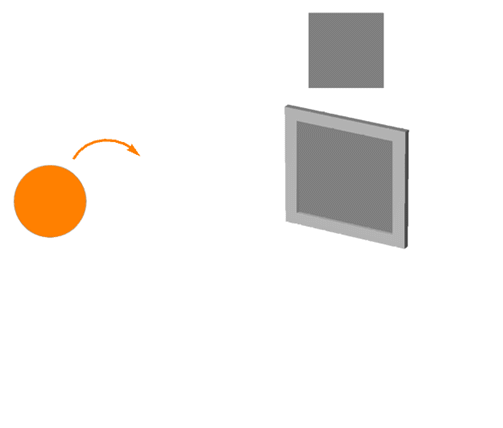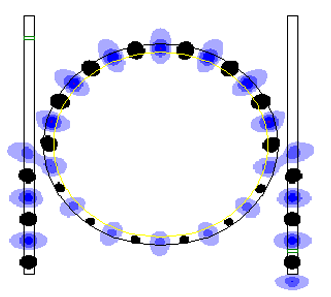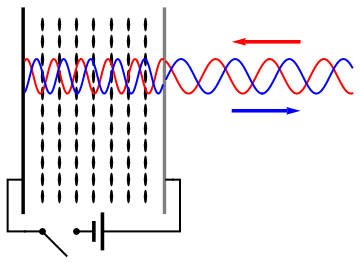|
Orbital Angular Momentum Of Light
The orbital angular momentum of light (OAM) is the component of angular momentum of a light beam that is dependent on the field spatial distribution, and not on the polarization. It can be further split into an internal and an external OAM. The internal OAM is an origin-independent angular momentum of a light beam that can be associated with a helical or twisted wavefront. The external OAM is the origin-dependent angular momentum that can be obtained as cross product of the light beam position (center of the beam) and its total linear momentum. Introduction A beam of light carries a linear momentum \mathbf, and hence it can be also attributed an external angular momentum \mathbf_e=\mathbf\times\mathbf. This external angular momentum depends on the choice of the origin of the coordinate system. If one chooses the origin at the beam axis and the beam is cylindrically symmetric (at least in its momentum distribution), the external angular momentum will vanish. The external angul ... [...More Info...] [...Related Items...] OR: [Wikipedia] [Google] [Baidu] |
Angular Momentum Of Light
The angular momentum of light is a Euclidean vector, vector quantity that expresses the amount of dynamical rotation present in the electromagnetic field of the light. While traveling approximately in a straight line, a beam of light can also be rotating (or "''spinning'', or "''twisting'') around its own axis. This rotation, while not visible to the naked eye, can be revealed by the interaction of the light beam with matter. There are two distinct forms of rotation of a light beam, one involving its Polarization (waves), polarization and the other its wavefront shape. These two forms of rotation are therefore associated with two distinct forms of angular momentum, respectively named light spin angular momentum (SAM) and light orbital angular momentum (OAM). The total angular momentum of light (or, more generally, of the electromagnetic field and the other force fields) and matter is conserved in time. Introduction Light, or more generally an electromagnetic wave, carries not ... [...More Info...] [...Related Items...] OR: [Wikipedia] [Google] [Baidu] |
Laguerre-Gaussian Mode
In optics, a Gaussian beam is a beam of electromagnetic radiation with high monochromaticity whose amplitude envelope in the transverse plane is given by a Gaussian function; this also implies a Gaussian intensity (irradiance) profile. This fundamental (or TEM00) transverse Gaussian mode describes the intended output of most (but not all) lasers, as such a beam can be focused into the most concentrated spot. When such a beam is refocused by a lens, the transverse ''phase'' dependence is altered; this results in a ''different'' Gaussian beam. The electric and magnetic field amplitude profiles along any such circular Gaussian beam (for a given wavelength and polarization) are determined by a single parameter: the so-called waist . At any position relative to the waist (focus) along a beam having a specified , the field amplitudes and phases are thereby determinedSvelto, pp. 153–5. as detailed below. The equations below assume a beam with a circular cross-section at all ... [...More Info...] [...Related Items...] OR: [Wikipedia] [Google] [Baidu] |
Optical Fibres
An optical fiber, or optical fibre in Commonwealth English, is a flexible, transparent fiber made by drawing glass (silica) or plastic to a diameter slightly thicker than that of a human hair. Optical fibers are used most often as a means to transmit light between the two ends of the fiber and find wide usage in fiber-optic communications, where they permit transmission over longer distances and at higher bandwidths (data transfer rates) than electrical cables. Fibers are used instead of metal wires because signals travel along them with less loss; in addition, fibers are immune to electromagnetic interference, a problem from which metal wires suffer. Fibers are also used for illumination and imaging, and are often wrapped in bundles so they may be used to carry light into, or images out of confined spaces, as in the case of a fiberscope. Specially designed fibers are also used for a variety of other applications, some of them being fiber optic sensors and fiber lasers. ... [...More Info...] [...Related Items...] OR: [Wikipedia] [Google] [Baidu] |
Meta-waveguide
In photonics, a meta-waveguide is a physical structures that guides electromagnetic waves with engineered functional subwavelength structures. Meta-waveguides are the result of combining the fields of metamaterials and metasurfaces into integrated optics. The design of the subwavelength architecture allows exotic waveguiding phenomena to be explored. Meta-waveguides can be classified by waveguide platforms or by design methods. If classified by underlying waveguide platform, engineered subwavelength structures can be classified in combination with dielectric waveguides, optical fibers, or plasmonic waveguides. If classified by design methods, meta-waveguides can be classified as either using design primarily by physical intuition, or by computer algorithm based inverse design methods. Meta-waveguides can provide new degrees of design freedom to the available structural library for optical waveguides in integrated photonics. Advantages can include enhancing the performance of co ... [...More Info...] [...Related Items...] OR: [Wikipedia] [Google] [Baidu] |
Holographic Grating
A holographic grating is a type of diffraction grating In optics, a diffraction grating is an optical component with a periodic structure that diffracts light into several beams travelling in different directions (i.e., different diffraction angles). The emerging coloration is a form of structur ... formed by an interference-fringe field of two laser beams whose standing-wave pattern is exposed to a set of photosensitive materials. The exposure triggers chemical processes within the sample and results in the formation of a periodic structure that has the same periodicity of the recorded pattern. One of the most interesting features of these structures is their versatility and tunability as the optical response strongly depends on the blend of used materials, and their interactions with light during, and after, the recording procedure. With the expertise earned over the years, nowadays holographic gratings are very efficient with no notable difference when compared to mechanic ... [...More Info...] [...Related Items...] OR: [Wikipedia] [Google] [Baidu] |
Optical Ring Resonators
An optical ring resonator is a set of waveguides in which at least one is a closed loop coupled to some sort of light input and output. (These can be, but are not limited to being, waveguides.) The concepts behind optical ring resonators are the same as those behind whispering galleries except that they use light and obey the properties behind constructive interference and total internal reflection. When light of the resonant wavelength is passed through the loop from the input waveguide, the light builds up in intensity over multiple round-trips owing to constructive interference and is output to the output bus waveguide which serves as a detector waveguide. Because only a select few wavelengths will be at resonance within the loop, the optical ring resonator functions as a filter. Additionally, as implied earlier, two or more ring waveguides can be coupled to each other to form an add/drop optical filter. Background Optical ring resonators work on the principles behind total ... [...More Info...] [...Related Items...] OR: [Wikipedia] [Google] [Baidu] |
Geometric Phase
In classical and quantum mechanics, geometric phase is a phase difference acquired over the course of a cycle, when a system is subjected to cyclic adiabatic processes, which results from the geometrical properties of the parameter space of the Hamiltonian. The phenomenon was independently discovered by S. Pancharatnam (1956), in classical optics and by H. C. Longuet-Higgins (1958)See page 12 in molecular physics; it was generalized by Sir Michael Berry in (1984). It is also known as the Pancharatnam–Berry phase, Pancharatnam phase, or Berry phase. It can be seen in the conical intersection of potential energy surfaces and in the Aharonov–Bohm effect. Geometric phase around the conical intersection involving the ground electronic state of the C6H3F3+ molecular ion is discussed on pages 385–386 of the textbook by Bunker and Jensen. In the case of the Aharonov–Bohm effect, the adiabatic parameter is the magnetic field enclosed by two interference paths, and it i ... [...More Info...] [...Related Items...] OR: [Wikipedia] [Google] [Baidu] |
Chromophores
A chromophore is the part of a molecule responsible for its color. The color that is seen by our eyes is the one not absorbed by the reflecting object within a certain wavelength spectrum of visible light. The chromophore is a region in the molecule where the energy difference between two separate molecular orbitals falls within the range of the visible spectrum. Visible light that hits the chromophore can thus be absorbed by exciting an electron from its ground state into an excited state. In biological molecules that serve to capture or detect light energy, the chromophore is the moiety that causes a conformational change in the molecule when hit by light. Conjugated pi-bond system chromophores Just like how two adjacent p-orbitals in a molecule will form a pi-bond, three or more adjacent p-orbitals in a molecule can form a conjugated pi-system. In a conjugated pi-system, electrons are able to capture certain photons as the electrons resonate along a certain distan ... [...More Info...] [...Related Items...] OR: [Wikipedia] [Google] [Baidu] |
Q-plate
A q-plate is an optical device that can form a light beam with orbital angular momentum (OAM) from a beam with well-defined spin angular momentum (SAM). Q-plates are based on the SAM-OAM coupling that may occur in media that are both anisotropic and inhomogeneous, such as an inhomogeneous anisotropic birefringent waveplate. Q-plates are also currently realized using total internal reflection devices, liquid crystals, metasurfaces based on polymers, and sub-wavelength In physics, the wavelength is the spatial period of a periodic wave—the distance over which the wave's shape repeats. It is the distance between consecutive corresponding points of the same phase on the wave, such as two adjacent crests, tro ... gratings. The sign of the OAM is controlled by the input beam's polarization. References Optical components Nonlinear optics {{optics-stub ... [...More Info...] [...Related Items...] OR: [Wikipedia] [Google] [Baidu] |
Spatial Light Modulator
A spatial light modulator (SLM) is an object that imposes some form of spatially varying modulation on a beam of light. A simple example is an overhead projector transparency. Usually when the term SLM is used, it means that the transparency can be controlled by a computer. In the 1980s, large SLMs were placed on overhead projectors to project computer monitor contents to the screen. Since then, more modern projectors have been developed where the SLM is built inside the projector. These are commonly used in meetings of all kinds for presentations. Usually, a SLM modulates the intensity of the light beam. However, it is also possible to produce devices that modulate the phase of the beam or both the intensity and the phase simultaneously. SLMs are used extensively in holographic data storage setups to encode information into a laser beam similarly to way a transparency does for an overhead projector. They can also be used as part of a holographic display technology. SLMs have ... [...More Info...] [...Related Items...] OR: [Wikipedia] [Google] [Baidu] |
Spiral Phase Plate
In mathematics, a spiral is a curve which emanates from a point, moving farther away as it revolves around the point. Helices Two major definitions of "spiral" in the American Heritage Dictionary are:Spiral ''American Heritage Dictionary of the English Language'', Houghton Mifflin Company, Fourth Edition, 2009. # a curve on a plane that winds around a fixed center point at a continuously increasing or decreasing distance from the point. # a three-dimensional curve that turns around an axis at a constant or continuously varying distance while moving parallel to the axis; a . The first definition describes a |
Generation Of OAM Beams Using SLM
A generation refers to all of the people Childbirth, born and Personhood, living at about the same time, regarded collectively. It can also be described as, "the average Era, period, generally considered to be about 20–30 years, during which children are born and Aging, grow up, become adults, and begin to have children." In kinship terminology, it is a structural term designating the parent-child relationship. It is known as biogenesis, reproduction, or procreation in the biology, biological sciences. ''Generation'' is also often used synonymously with ''Cohort (statistics), cohort'' in social science; under this formulation it means "people within a delineated population who experience the same significant events within a given period of time". Generations in this sense of birth cohort, also known as "social generations", are widely used in popular culture, and have been the basis for sociological analysis. Serious analysis of generations began in the nineteenth century, e ... [...More Info...] [...Related Items...] OR: [Wikipedia] [Google] [Baidu] |




.jpeg/1200px-Fall_Leaves_(199582361).jpeg)



